Cloud Computing Investment: Benefits and Drawbacks for Businesses
VerifiedAdded on 2020/03/01
|10
|3005
|91
Report
AI Summary
This report delves into the advantages and disadvantages of cloud computing for businesses, exploring its impact on various organizations. It begins by highlighting the benefits, such as enhanced service delivery, improved IT resource optimization, and increased business value, as exemplified by IBM's successful implementation of cloud services. The report also acknowledges the drawbacks, including data security risks, such as hacking and malware injection, data privacy concerns, and the potential for denial-of-service attacks. Through a literature review and examples from companies like Google Inc. and Zappos, the report evaluates the impact of cloud computing on both customers and service providers, providing a balanced perspective on its adoption and implications for business operations. The report also explores the need for businesses to consider the rapidly changing technological landscape and the associated costs of updating data centers to remain current with cloud computing advancements.
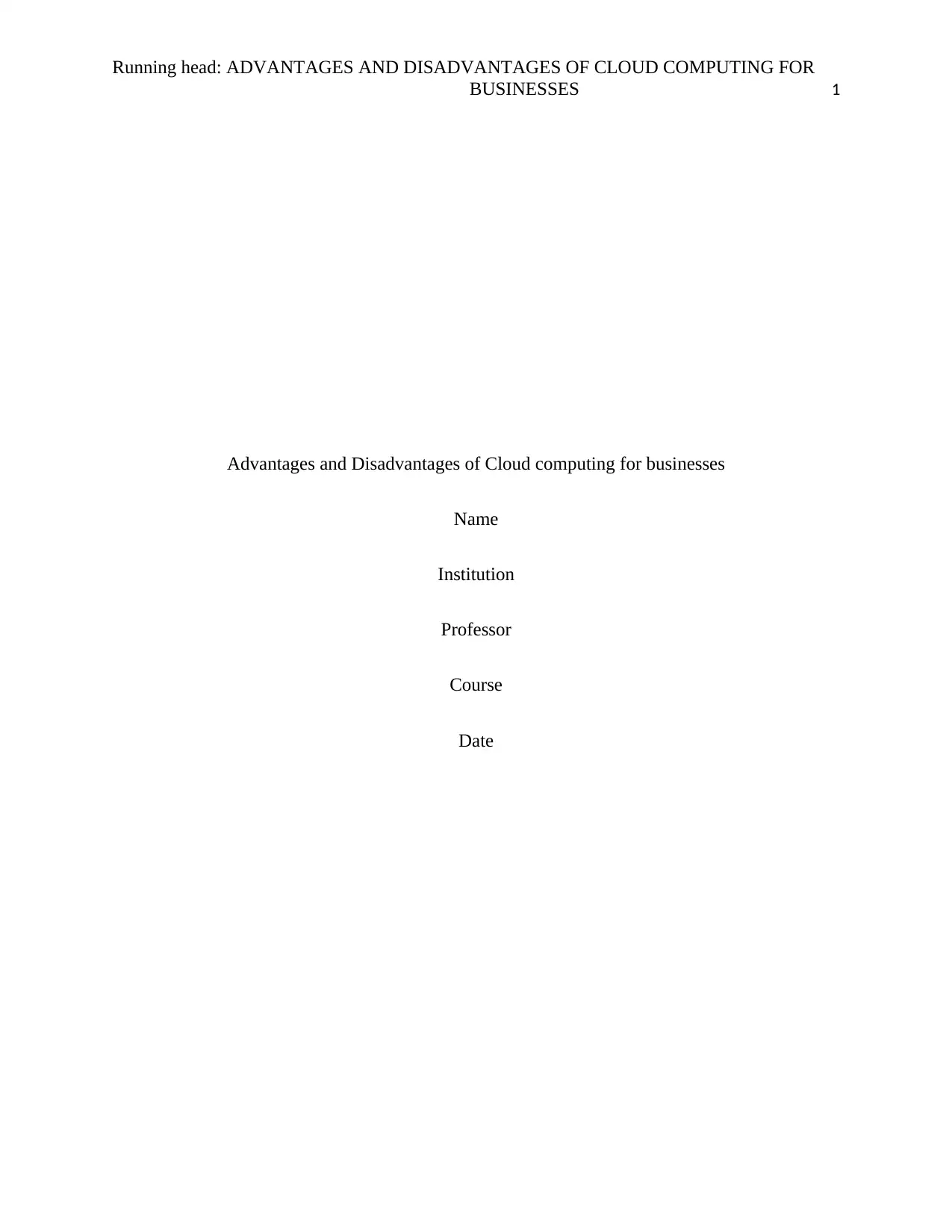
Running head: ADVANTAGES AND DISADVANTAGES OF CLOUD COMPUTING FOR
BUSINESSES 1
Advantages and Disadvantages of Cloud computing for businesses
Name
Institution
Professor
Course
Date
BUSINESSES 1
Advantages and Disadvantages of Cloud computing for businesses
Name
Institution
Professor
Course
Date
Paraphrase This Document
Need a fresh take? Get an instant paraphrase of this document with our AI Paraphraser
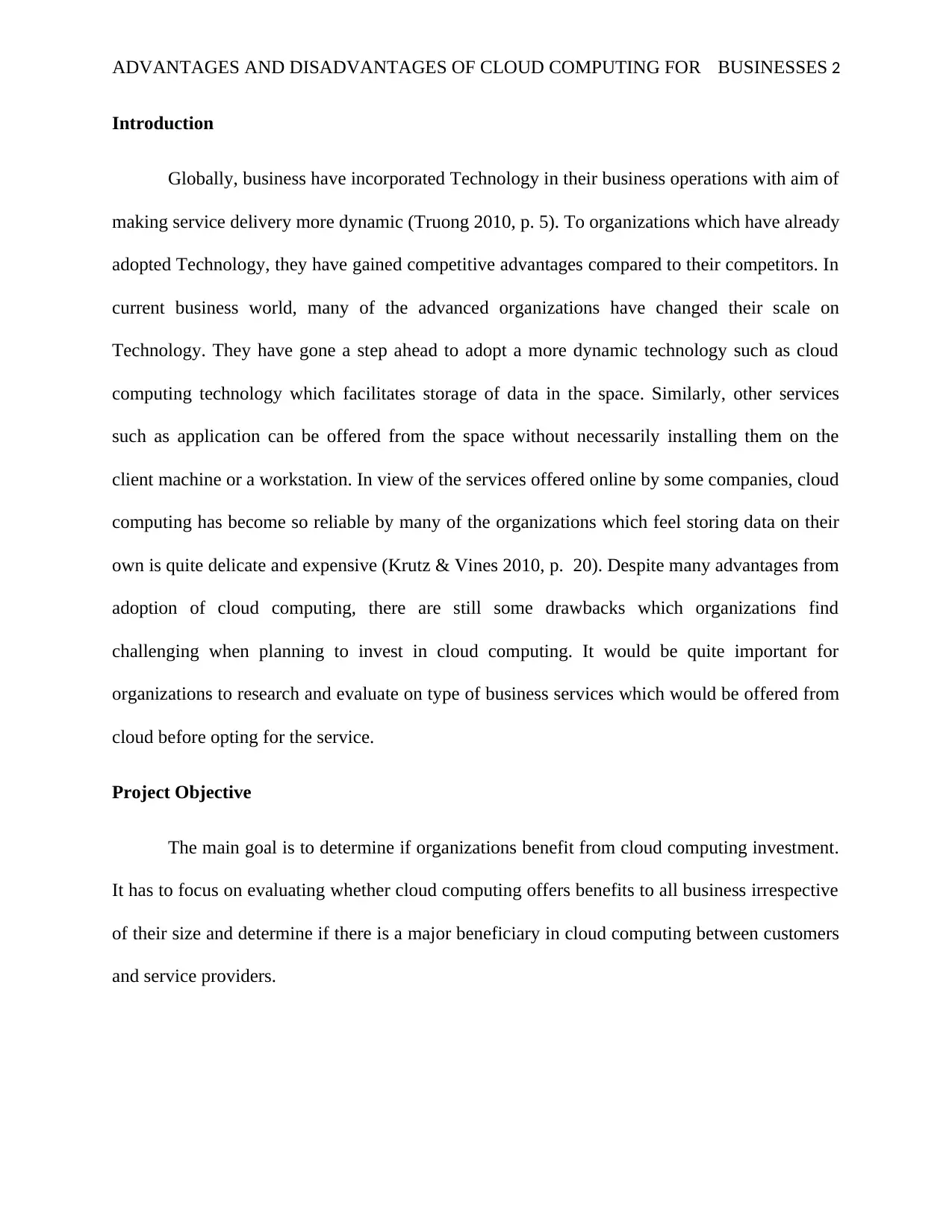
ADVANTAGES AND DISADVANTAGES OF CLOUD COMPUTING FOR BUSINESSES 2
Introduction
Globally, business have incorporated Technology in their business operations with aim of
making service delivery more dynamic (Truong 2010, p. 5). To organizations which have already
adopted Technology, they have gained competitive advantages compared to their competitors. In
current business world, many of the advanced organizations have changed their scale on
Technology. They have gone a step ahead to adopt a more dynamic technology such as cloud
computing technology which facilitates storage of data in the space. Similarly, other services
such as application can be offered from the space without necessarily installing them on the
client machine or a workstation. In view of the services offered online by some companies, cloud
computing has become so reliable by many of the organizations which feel storing data on their
own is quite delicate and expensive (Krutz & Vines 2010, p. 20). Despite many advantages from
adoption of cloud computing, there are still some drawbacks which organizations find
challenging when planning to invest in cloud computing. It would be quite important for
organizations to research and evaluate on type of business services which would be offered from
cloud before opting for the service.
Project Objective
The main goal is to determine if organizations benefit from cloud computing investment.
It has to focus on evaluating whether cloud computing offers benefits to all business irrespective
of their size and determine if there is a major beneficiary in cloud computing between customers
and service providers.
Introduction
Globally, business have incorporated Technology in their business operations with aim of
making service delivery more dynamic (Truong 2010, p. 5). To organizations which have already
adopted Technology, they have gained competitive advantages compared to their competitors. In
current business world, many of the advanced organizations have changed their scale on
Technology. They have gone a step ahead to adopt a more dynamic technology such as cloud
computing technology which facilitates storage of data in the space. Similarly, other services
such as application can be offered from the space without necessarily installing them on the
client machine or a workstation. In view of the services offered online by some companies, cloud
computing has become so reliable by many of the organizations which feel storing data on their
own is quite delicate and expensive (Krutz & Vines 2010, p. 20). Despite many advantages from
adoption of cloud computing, there are still some drawbacks which organizations find
challenging when planning to invest in cloud computing. It would be quite important for
organizations to research and evaluate on type of business services which would be offered from
cloud before opting for the service.
Project Objective
The main goal is to determine if organizations benefit from cloud computing investment.
It has to focus on evaluating whether cloud computing offers benefits to all business irrespective
of their size and determine if there is a major beneficiary in cloud computing between customers
and service providers.
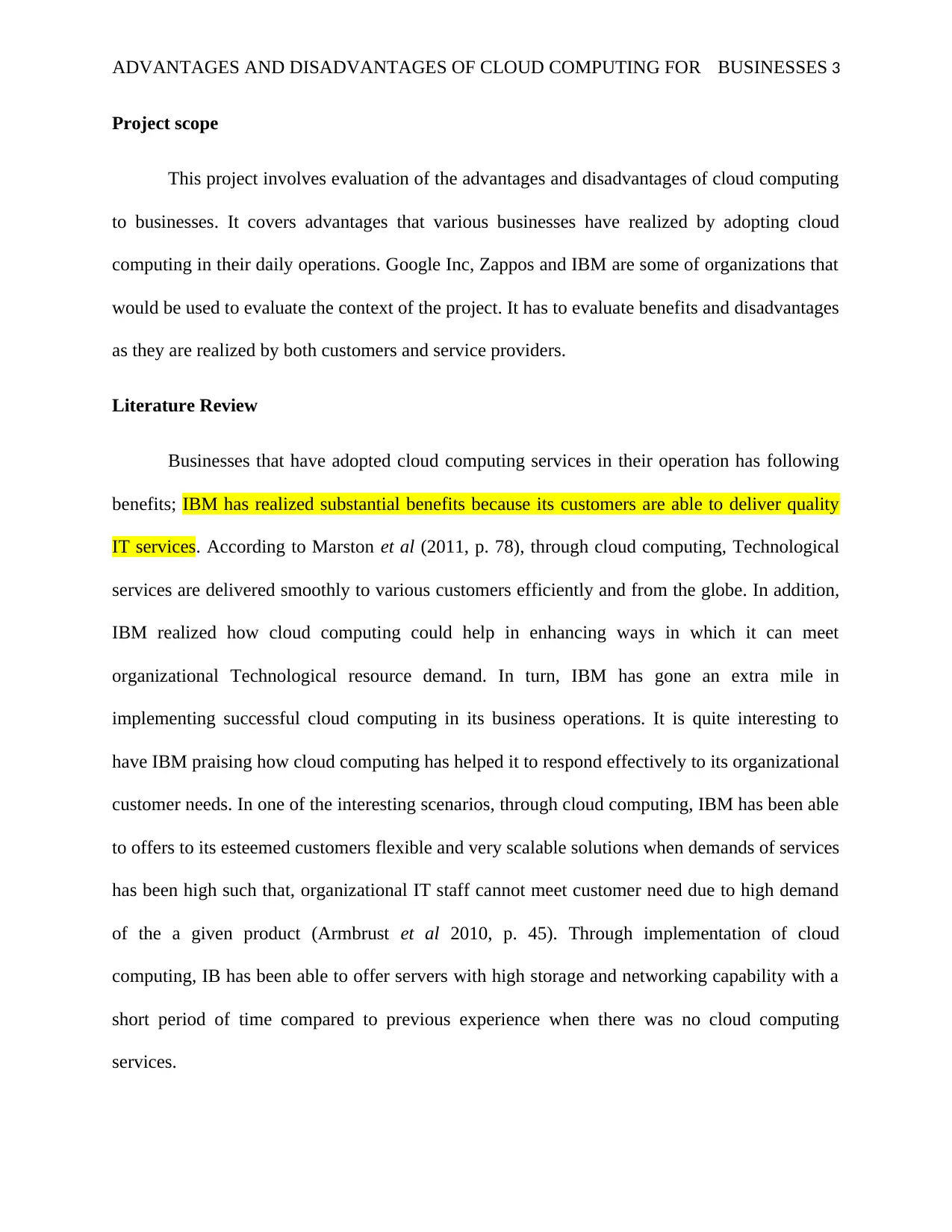
ADVANTAGES AND DISADVANTAGES OF CLOUD COMPUTING FOR BUSINESSES 3
Project scope
This project involves evaluation of the advantages and disadvantages of cloud computing
to businesses. It covers advantages that various businesses have realized by adopting cloud
computing in their daily operations. Google Inc, Zappos and IBM are some of organizations that
would be used to evaluate the context of the project. It has to evaluate benefits and disadvantages
as they are realized by both customers and service providers.
Literature Review
Businesses that have adopted cloud computing services in their operation has following
benefits; IBM has realized substantial benefits because its customers are able to deliver quality
IT services. According to Marston et al (2011, p. 78), through cloud computing, Technological
services are delivered smoothly to various customers efficiently and from the globe. In addition,
IBM realized how cloud computing could help in enhancing ways in which it can meet
organizational Technological resource demand. In turn, IBM has gone an extra mile in
implementing successful cloud computing in its business operations. It is quite interesting to
have IBM praising how cloud computing has helped it to respond effectively to its organizational
customer needs. In one of the interesting scenarios, through cloud computing, IBM has been able
to offers to its esteemed customers flexible and very scalable solutions when demands of services
has been high such that, organizational IT staff cannot meet customer need due to high demand
of the a given product (Armbrust et al 2010, p. 45). Through implementation of cloud
computing, IB has been able to offer servers with high storage and networking capability with a
short period of time compared to previous experience when there was no cloud computing
services.
Project scope
This project involves evaluation of the advantages and disadvantages of cloud computing
to businesses. It covers advantages that various businesses have realized by adopting cloud
computing in their daily operations. Google Inc, Zappos and IBM are some of organizations that
would be used to evaluate the context of the project. It has to evaluate benefits and disadvantages
as they are realized by both customers and service providers.
Literature Review
Businesses that have adopted cloud computing services in their operation has following
benefits; IBM has realized substantial benefits because its customers are able to deliver quality
IT services. According to Marston et al (2011, p. 78), through cloud computing, Technological
services are delivered smoothly to various customers efficiently and from the globe. In addition,
IBM realized how cloud computing could help in enhancing ways in which it can meet
organizational Technological resource demand. In turn, IBM has gone an extra mile in
implementing successful cloud computing in its business operations. It is quite interesting to
have IBM praising how cloud computing has helped it to respond effectively to its organizational
customer needs. In one of the interesting scenarios, through cloud computing, IBM has been able
to offers to its esteemed customers flexible and very scalable solutions when demands of services
has been high such that, organizational IT staff cannot meet customer need due to high demand
of the a given product (Armbrust et al 2010, p. 45). Through implementation of cloud
computing, IB has been able to offer servers with high storage and networking capability with a
short period of time compared to previous experience when there was no cloud computing
services.
⊘ This is a preview!⊘
Do you want full access?
Subscribe today to unlock all pages.

Trusted by 1+ million students worldwide
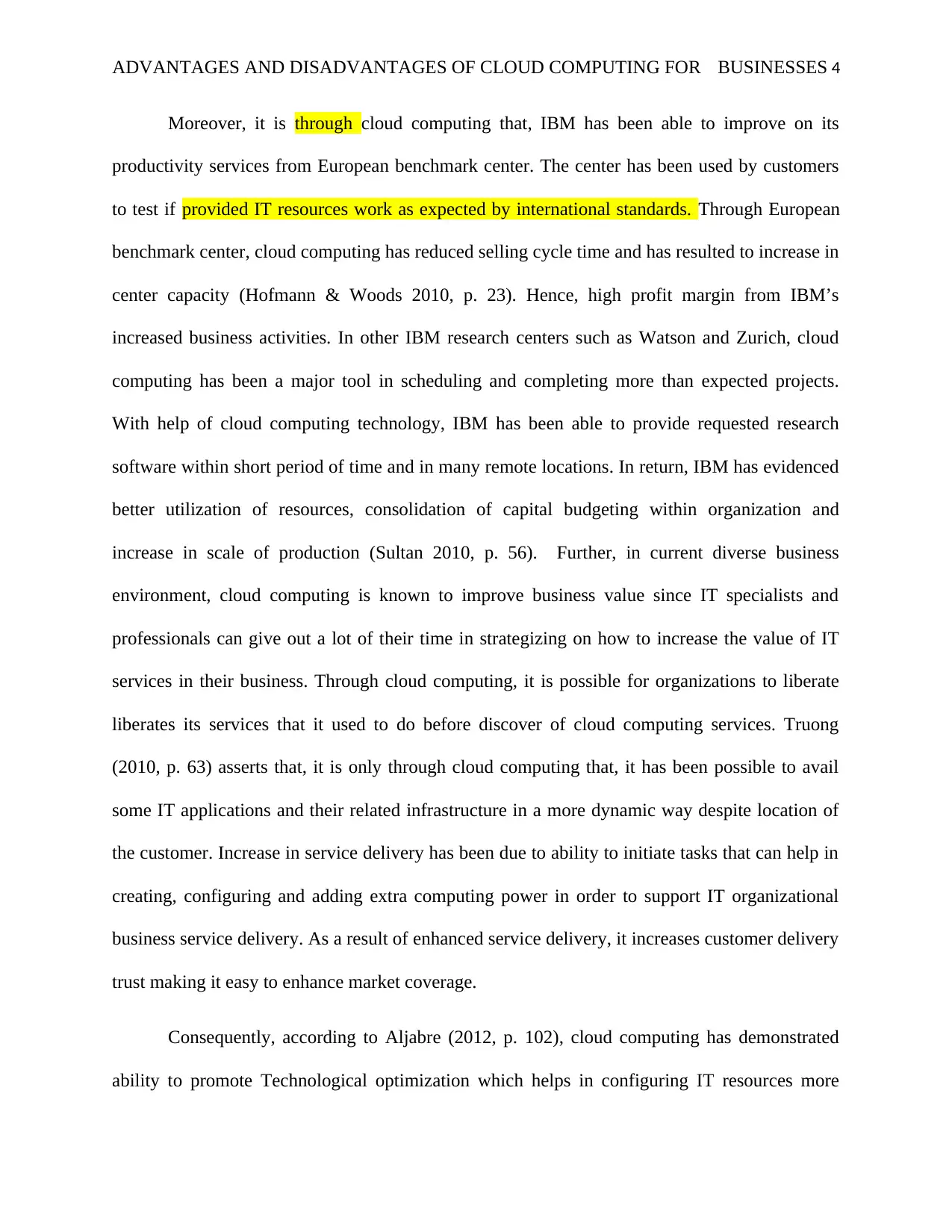
ADVANTAGES AND DISADVANTAGES OF CLOUD COMPUTING FOR BUSINESSES 4
Moreover, it is through cloud computing that, IBM has been able to improve on its
productivity services from European benchmark center. The center has been used by customers
to test if provided IT resources work as expected by international standards. Through European
benchmark center, cloud computing has reduced selling cycle time and has resulted to increase in
center capacity (Hofmann & Woods 2010, p. 23). Hence, high profit margin from IBM’s
increased business activities. In other IBM research centers such as Watson and Zurich, cloud
computing has been a major tool in scheduling and completing more than expected projects.
With help of cloud computing technology, IBM has been able to provide requested research
software within short period of time and in many remote locations. In return, IBM has evidenced
better utilization of resources, consolidation of capital budgeting within organization and
increase in scale of production (Sultan 2010, p. 56). Further, in current diverse business
environment, cloud computing is known to improve business value since IT specialists and
professionals can give out a lot of their time in strategizing on how to increase the value of IT
services in their business. Through cloud computing, it is possible for organizations to liberate
liberates its services that it used to do before discover of cloud computing services. Truong
(2010, p. 63) asserts that, it is only through cloud computing that, it has been possible to avail
some IT applications and their related infrastructure in a more dynamic way despite location of
the customer. Increase in service delivery has been due to ability to initiate tasks that can help in
creating, configuring and adding extra computing power in order to support IT organizational
business service delivery. As a result of enhanced service delivery, it increases customer delivery
trust making it easy to enhance market coverage.
Consequently, according to Aljabre (2012, p. 102), cloud computing has demonstrated
ability to promote Technological optimization which helps in configuring IT resources more
Moreover, it is through cloud computing that, IBM has been able to improve on its
productivity services from European benchmark center. The center has been used by customers
to test if provided IT resources work as expected by international standards. Through European
benchmark center, cloud computing has reduced selling cycle time and has resulted to increase in
center capacity (Hofmann & Woods 2010, p. 23). Hence, high profit margin from IBM’s
increased business activities. In other IBM research centers such as Watson and Zurich, cloud
computing has been a major tool in scheduling and completing more than expected projects.
With help of cloud computing technology, IBM has been able to provide requested research
software within short period of time and in many remote locations. In return, IBM has evidenced
better utilization of resources, consolidation of capital budgeting within organization and
increase in scale of production (Sultan 2010, p. 56). Further, in current diverse business
environment, cloud computing is known to improve business value since IT specialists and
professionals can give out a lot of their time in strategizing on how to increase the value of IT
services in their business. Through cloud computing, it is possible for organizations to liberate
liberates its services that it used to do before discover of cloud computing services. Truong
(2010, p. 63) asserts that, it is only through cloud computing that, it has been possible to avail
some IT applications and their related infrastructure in a more dynamic way despite location of
the customer. Increase in service delivery has been due to ability to initiate tasks that can help in
creating, configuring and adding extra computing power in order to support IT organizational
business service delivery. As a result of enhanced service delivery, it increases customer delivery
trust making it easy to enhance market coverage.
Consequently, according to Aljabre (2012, p. 102), cloud computing has demonstrated
ability to promote Technological optimization which helps in configuring IT resources more
Paraphrase This Document
Need a fresh take? Get an instant paraphrase of this document with our AI Paraphraser
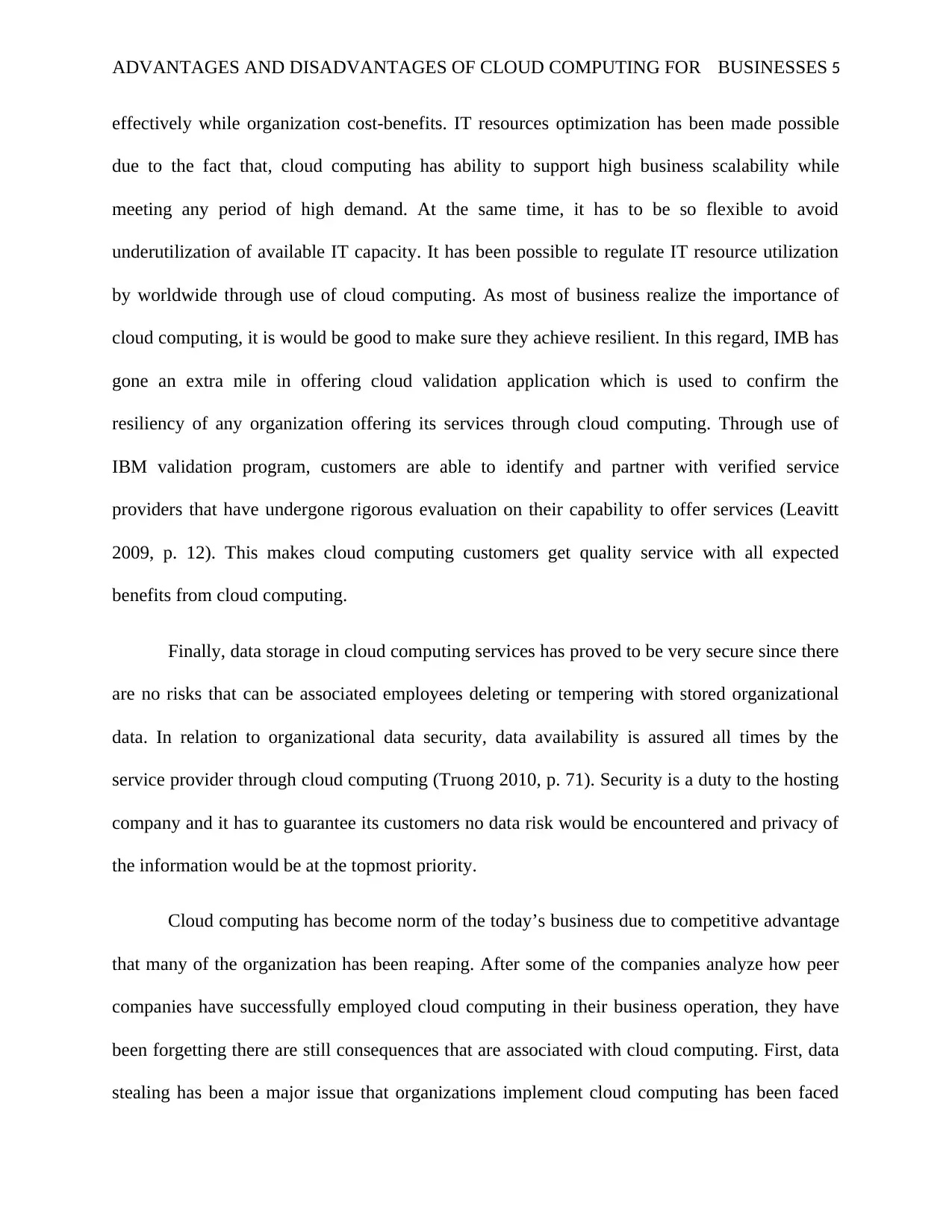
ADVANTAGES AND DISADVANTAGES OF CLOUD COMPUTING FOR BUSINESSES 5
effectively while organization cost-benefits. IT resources optimization has been made possible
due to the fact that, cloud computing has ability to support high business scalability while
meeting any period of high demand. At the same time, it has to be so flexible to avoid
underutilization of available IT capacity. It has been possible to regulate IT resource utilization
by worldwide through use of cloud computing. As most of business realize the importance of
cloud computing, it is would be good to make sure they achieve resilient. In this regard, IMB has
gone an extra mile in offering cloud validation application which is used to confirm the
resiliency of any organization offering its services through cloud computing. Through use of
IBM validation program, customers are able to identify and partner with verified service
providers that have undergone rigorous evaluation on their capability to offer services (Leavitt
2009, p. 12). This makes cloud computing customers get quality service with all expected
benefits from cloud computing.
Finally, data storage in cloud computing services has proved to be very secure since there
are no risks that can be associated employees deleting or tempering with stored organizational
data. In relation to organizational data security, data availability is assured all times by the
service provider through cloud computing (Truong 2010, p. 71). Security is a duty to the hosting
company and it has to guarantee its customers no data risk would be encountered and privacy of
the information would be at the topmost priority.
Cloud computing has become norm of the today’s business due to competitive advantage
that many of the organization has been reaping. After some of the companies analyze how peer
companies have successfully employed cloud computing in their business operation, they have
been forgetting there are still consequences that are associated with cloud computing. First, data
stealing has been a major issue that organizations implement cloud computing has been faced
effectively while organization cost-benefits. IT resources optimization has been made possible
due to the fact that, cloud computing has ability to support high business scalability while
meeting any period of high demand. At the same time, it has to be so flexible to avoid
underutilization of available IT capacity. It has been possible to regulate IT resource utilization
by worldwide through use of cloud computing. As most of business realize the importance of
cloud computing, it is would be good to make sure they achieve resilient. In this regard, IMB has
gone an extra mile in offering cloud validation application which is used to confirm the
resiliency of any organization offering its services through cloud computing. Through use of
IBM validation program, customers are able to identify and partner with verified service
providers that have undergone rigorous evaluation on their capability to offer services (Leavitt
2009, p. 12). This makes cloud computing customers get quality service with all expected
benefits from cloud computing.
Finally, data storage in cloud computing services has proved to be very secure since there
are no risks that can be associated employees deleting or tempering with stored organizational
data. In relation to organizational data security, data availability is assured all times by the
service provider through cloud computing (Truong 2010, p. 71). Security is a duty to the hosting
company and it has to guarantee its customers no data risk would be encountered and privacy of
the information would be at the topmost priority.
Cloud computing has become norm of the today’s business due to competitive advantage
that many of the organization has been reaping. After some of the companies analyze how peer
companies have successfully employed cloud computing in their business operation, they have
been forgetting there are still consequences that are associated with cloud computing. First, data
stealing has been a major issue that organizations implement cloud computing has been faced
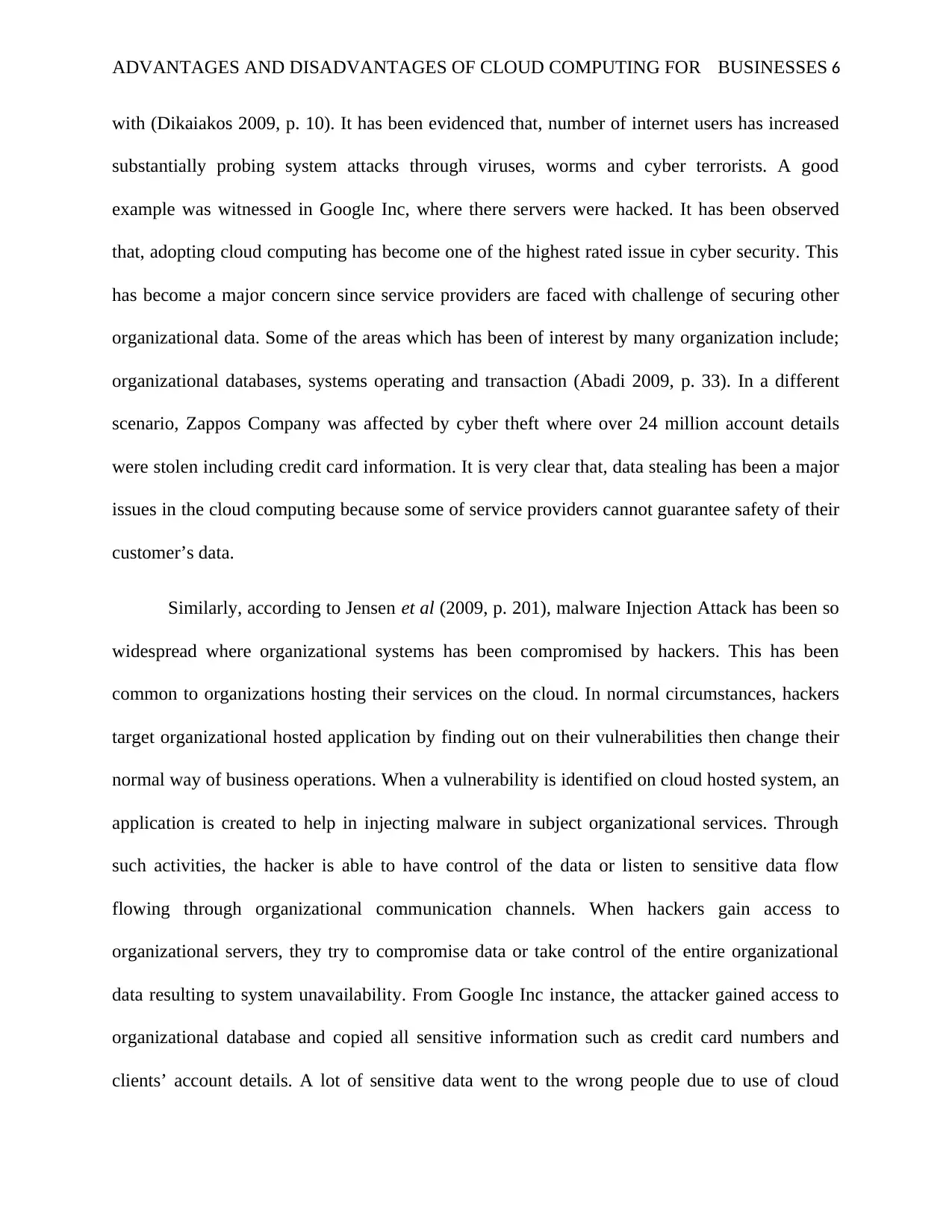
ADVANTAGES AND DISADVANTAGES OF CLOUD COMPUTING FOR BUSINESSES 6
with (Dikaiakos 2009, p. 10). It has been evidenced that, number of internet users has increased
substantially probing system attacks through viruses, worms and cyber terrorists. A good
example was witnessed in Google Inc, where there servers were hacked. It has been observed
that, adopting cloud computing has become one of the highest rated issue in cyber security. This
has become a major concern since service providers are faced with challenge of securing other
organizational data. Some of the areas which has been of interest by many organization include;
organizational databases, systems operating and transaction (Abadi 2009, p. 33). In a different
scenario, Zappos Company was affected by cyber theft where over 24 million account details
were stolen including credit card information. It is very clear that, data stealing has been a major
issues in the cloud computing because some of service providers cannot guarantee safety of their
customer’s data.
Similarly, according to Jensen et al (2009, p. 201), malware Injection Attack has been so
widespread where organizational systems has been compromised by hackers. This has been
common to organizations hosting their services on the cloud. In normal circumstances, hackers
target organizational hosted application by finding out on their vulnerabilities then change their
normal way of business operations. When a vulnerability is identified on cloud hosted system, an
application is created to help in injecting malware in subject organizational services. Through
such activities, the hacker is able to have control of the data or listen to sensitive data flow
flowing through organizational communication channels. When hackers gain access to
organizational servers, they try to compromise data or take control of the entire organizational
data resulting to system unavailability. From Google Inc instance, the attacker gained access to
organizational database and copied all sensitive information such as credit card numbers and
clients’ account details. A lot of sensitive data went to the wrong people due to use of cloud
with (Dikaiakos 2009, p. 10). It has been evidenced that, number of internet users has increased
substantially probing system attacks through viruses, worms and cyber terrorists. A good
example was witnessed in Google Inc, where there servers were hacked. It has been observed
that, adopting cloud computing has become one of the highest rated issue in cyber security. This
has become a major concern since service providers are faced with challenge of securing other
organizational data. Some of the areas which has been of interest by many organization include;
organizational databases, systems operating and transaction (Abadi 2009, p. 33). In a different
scenario, Zappos Company was affected by cyber theft where over 24 million account details
were stolen including credit card information. It is very clear that, data stealing has been a major
issues in the cloud computing because some of service providers cannot guarantee safety of their
customer’s data.
Similarly, according to Jensen et al (2009, p. 201), malware Injection Attack has been so
widespread where organizational systems has been compromised by hackers. This has been
common to organizations hosting their services on the cloud. In normal circumstances, hackers
target organizational hosted application by finding out on their vulnerabilities then change their
normal way of business operations. When a vulnerability is identified on cloud hosted system, an
application is created to help in injecting malware in subject organizational services. Through
such activities, the hacker is able to have control of the data or listen to sensitive data flow
flowing through organizational communication channels. When hackers gain access to
organizational servers, they try to compromise data or take control of the entire organizational
data resulting to system unavailability. From Google Inc instance, the attacker gained access to
organizational database and copied all sensitive information such as credit card numbers and
clients’ account details. A lot of sensitive data went to the wrong people due to use of cloud
⊘ This is a preview!⊘
Do you want full access?
Subscribe today to unlock all pages.

Trusted by 1+ million students worldwide
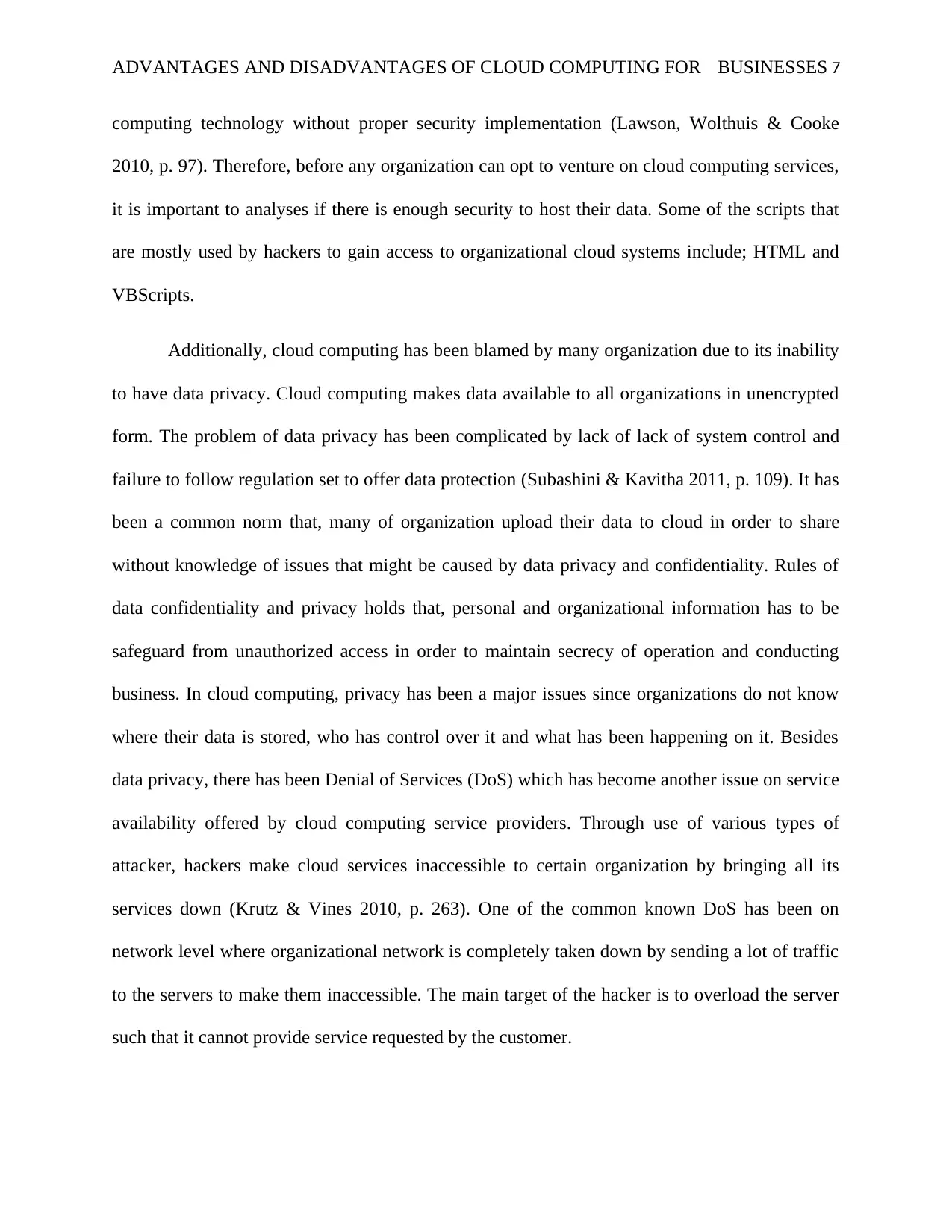
ADVANTAGES AND DISADVANTAGES OF CLOUD COMPUTING FOR BUSINESSES 7
computing technology without proper security implementation (Lawson, Wolthuis & Cooke
2010, p. 97). Therefore, before any organization can opt to venture on cloud computing services,
it is important to analyses if there is enough security to host their data. Some of the scripts that
are mostly used by hackers to gain access to organizational cloud systems include; HTML and
VBScripts.
Additionally, cloud computing has been blamed by many organization due to its inability
to have data privacy. Cloud computing makes data available to all organizations in unencrypted
form. The problem of data privacy has been complicated by lack of lack of system control and
failure to follow regulation set to offer data protection (Subashini & Kavitha 2011, p. 109). It has
been a common norm that, many of organization upload their data to cloud in order to share
without knowledge of issues that might be caused by data privacy and confidentiality. Rules of
data confidentiality and privacy holds that, personal and organizational information has to be
safeguard from unauthorized access in order to maintain secrecy of operation and conducting
business. In cloud computing, privacy has been a major issues since organizations do not know
where their data is stored, who has control over it and what has been happening on it. Besides
data privacy, there has been Denial of Services (DoS) which has become another issue on service
availability offered by cloud computing service providers. Through use of various types of
attacker, hackers make cloud services inaccessible to certain organization by bringing all its
services down (Krutz & Vines 2010, p. 263). One of the common known DoS has been on
network level where organizational network is completely taken down by sending a lot of traffic
to the servers to make them inaccessible. The main target of the hacker is to overload the server
such that it cannot provide service requested by the customer.
computing technology without proper security implementation (Lawson, Wolthuis & Cooke
2010, p. 97). Therefore, before any organization can opt to venture on cloud computing services,
it is important to analyses if there is enough security to host their data. Some of the scripts that
are mostly used by hackers to gain access to organizational cloud systems include; HTML and
VBScripts.
Additionally, cloud computing has been blamed by many organization due to its inability
to have data privacy. Cloud computing makes data available to all organizations in unencrypted
form. The problem of data privacy has been complicated by lack of lack of system control and
failure to follow regulation set to offer data protection (Subashini & Kavitha 2011, p. 109). It has
been a common norm that, many of organization upload their data to cloud in order to share
without knowledge of issues that might be caused by data privacy and confidentiality. Rules of
data confidentiality and privacy holds that, personal and organizational information has to be
safeguard from unauthorized access in order to maintain secrecy of operation and conducting
business. In cloud computing, privacy has been a major issues since organizations do not know
where their data is stored, who has control over it and what has been happening on it. Besides
data privacy, there has been Denial of Services (DoS) which has become another issue on service
availability offered by cloud computing service providers. Through use of various types of
attacker, hackers make cloud services inaccessible to certain organization by bringing all its
services down (Krutz & Vines 2010, p. 263). One of the common known DoS has been on
network level where organizational network is completely taken down by sending a lot of traffic
to the servers to make them inaccessible. The main target of the hacker is to overload the server
such that it cannot provide service requested by the customer.
Paraphrase This Document
Need a fresh take? Get an instant paraphrase of this document with our AI Paraphraser
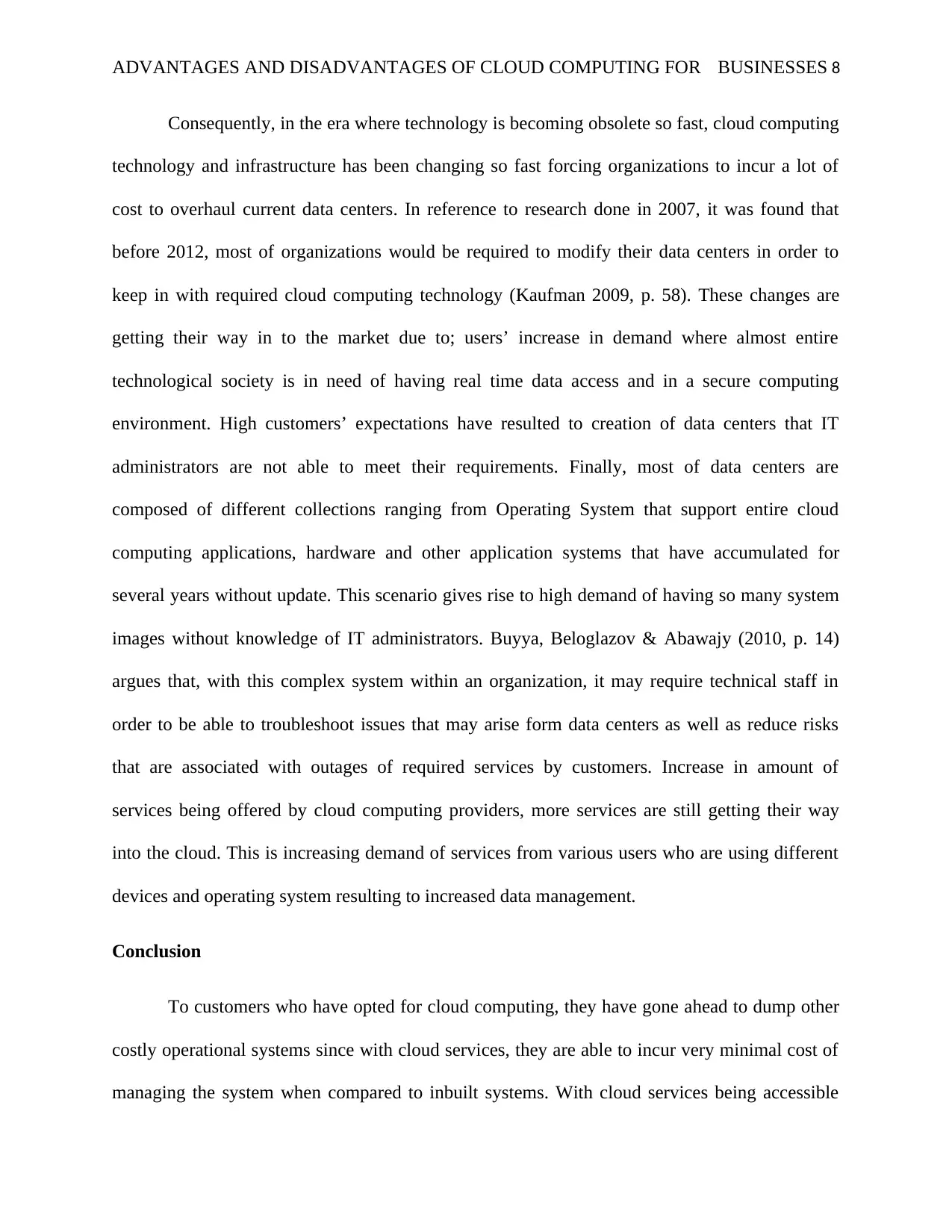
ADVANTAGES AND DISADVANTAGES OF CLOUD COMPUTING FOR BUSINESSES 8
Consequently, in the era where technology is becoming obsolete so fast, cloud computing
technology and infrastructure has been changing so fast forcing organizations to incur a lot of
cost to overhaul current data centers. In reference to research done in 2007, it was found that
before 2012, most of organizations would be required to modify their data centers in order to
keep in with required cloud computing technology (Kaufman 2009, p. 58). These changes are
getting their way in to the market due to; users’ increase in demand where almost entire
technological society is in need of having real time data access and in a secure computing
environment. High customers’ expectations have resulted to creation of data centers that IT
administrators are not able to meet their requirements. Finally, most of data centers are
composed of different collections ranging from Operating System that support entire cloud
computing applications, hardware and other application systems that have accumulated for
several years without update. This scenario gives rise to high demand of having so many system
images without knowledge of IT administrators. Buyya, Beloglazov & Abawajy (2010, p. 14)
argues that, with this complex system within an organization, it may require technical staff in
order to be able to troubleshoot issues that may arise form data centers as well as reduce risks
that are associated with outages of required services by customers. Increase in amount of
services being offered by cloud computing providers, more services are still getting their way
into the cloud. This is increasing demand of services from various users who are using different
devices and operating system resulting to increased data management.
Conclusion
To customers who have opted for cloud computing, they have gone ahead to dump other
costly operational systems since with cloud services, they are able to incur very minimal cost of
managing the system when compared to inbuilt systems. With cloud services being accessible
Consequently, in the era where technology is becoming obsolete so fast, cloud computing
technology and infrastructure has been changing so fast forcing organizations to incur a lot of
cost to overhaul current data centers. In reference to research done in 2007, it was found that
before 2012, most of organizations would be required to modify their data centers in order to
keep in with required cloud computing technology (Kaufman 2009, p. 58). These changes are
getting their way in to the market due to; users’ increase in demand where almost entire
technological society is in need of having real time data access and in a secure computing
environment. High customers’ expectations have resulted to creation of data centers that IT
administrators are not able to meet their requirements. Finally, most of data centers are
composed of different collections ranging from Operating System that support entire cloud
computing applications, hardware and other application systems that have accumulated for
several years without update. This scenario gives rise to high demand of having so many system
images without knowledge of IT administrators. Buyya, Beloglazov & Abawajy (2010, p. 14)
argues that, with this complex system within an organization, it may require technical staff in
order to be able to troubleshoot issues that may arise form data centers as well as reduce risks
that are associated with outages of required services by customers. Increase in amount of
services being offered by cloud computing providers, more services are still getting their way
into the cloud. This is increasing demand of services from various users who are using different
devices and operating system resulting to increased data management.
Conclusion
To customers who have opted for cloud computing, they have gone ahead to dump other
costly operational systems since with cloud services, they are able to incur very minimal cost of
managing the system when compared to inbuilt systems. With cloud services being accessible
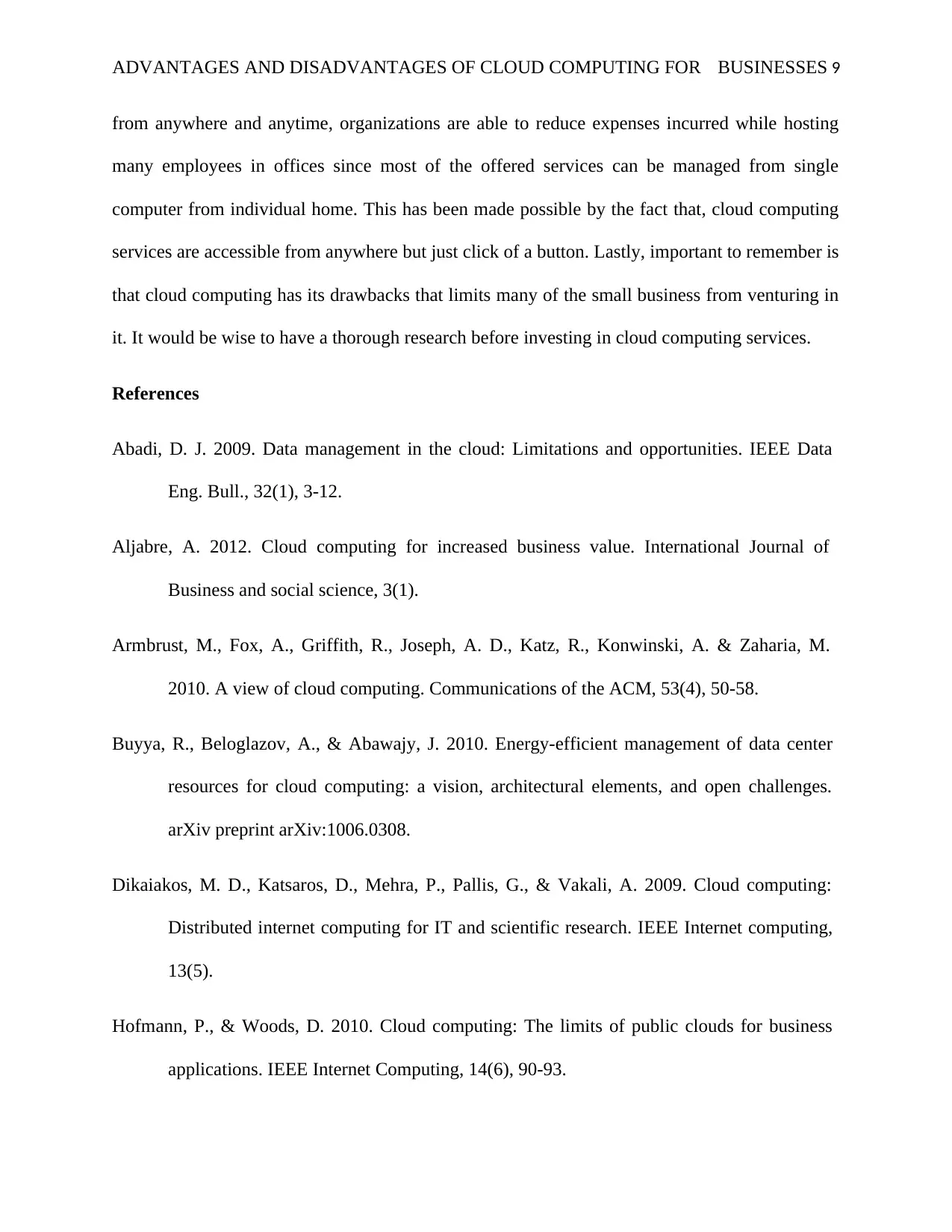
ADVANTAGES AND DISADVANTAGES OF CLOUD COMPUTING FOR BUSINESSES 9
from anywhere and anytime, organizations are able to reduce expenses incurred while hosting
many employees in offices since most of the offered services can be managed from single
computer from individual home. This has been made possible by the fact that, cloud computing
services are accessible from anywhere but just click of a button. Lastly, important to remember is
that cloud computing has its drawbacks that limits many of the small business from venturing in
it. It would be wise to have a thorough research before investing in cloud computing services.
References
Abadi, D. J. 2009. Data management in the cloud: Limitations and opportunities. IEEE Data
Eng. Bull., 32(1), 3-12.
Aljabre, A. 2012. Cloud computing for increased business value. International Journal of
Business and social science, 3(1).
Armbrust, M., Fox, A., Griffith, R., Joseph, A. D., Katz, R., Konwinski, A. & Zaharia, M.
2010. A view of cloud computing. Communications of the ACM, 53(4), 50-58.
Buyya, R., Beloglazov, A., & Abawajy, J. 2010. Energy-efficient management of data center
resources for cloud computing: a vision, architectural elements, and open challenges.
arXiv preprint arXiv:1006.0308.
Dikaiakos, M. D., Katsaros, D., Mehra, P., Pallis, G., & Vakali, A. 2009. Cloud computing:
Distributed internet computing for IT and scientific research. IEEE Internet computing,
13(5).
Hofmann, P., & Woods, D. 2010. Cloud computing: The limits of public clouds for business
applications. IEEE Internet Computing, 14(6), 90-93.
from anywhere and anytime, organizations are able to reduce expenses incurred while hosting
many employees in offices since most of the offered services can be managed from single
computer from individual home. This has been made possible by the fact that, cloud computing
services are accessible from anywhere but just click of a button. Lastly, important to remember is
that cloud computing has its drawbacks that limits many of the small business from venturing in
it. It would be wise to have a thorough research before investing in cloud computing services.
References
Abadi, D. J. 2009. Data management in the cloud: Limitations and opportunities. IEEE Data
Eng. Bull., 32(1), 3-12.
Aljabre, A. 2012. Cloud computing for increased business value. International Journal of
Business and social science, 3(1).
Armbrust, M., Fox, A., Griffith, R., Joseph, A. D., Katz, R., Konwinski, A. & Zaharia, M.
2010. A view of cloud computing. Communications of the ACM, 53(4), 50-58.
Buyya, R., Beloglazov, A., & Abawajy, J. 2010. Energy-efficient management of data center
resources for cloud computing: a vision, architectural elements, and open challenges.
arXiv preprint arXiv:1006.0308.
Dikaiakos, M. D., Katsaros, D., Mehra, P., Pallis, G., & Vakali, A. 2009. Cloud computing:
Distributed internet computing for IT and scientific research. IEEE Internet computing,
13(5).
Hofmann, P., & Woods, D. 2010. Cloud computing: The limits of public clouds for business
applications. IEEE Internet Computing, 14(6), 90-93.
⊘ This is a preview!⊘
Do you want full access?
Subscribe today to unlock all pages.

Trusted by 1+ million students worldwide
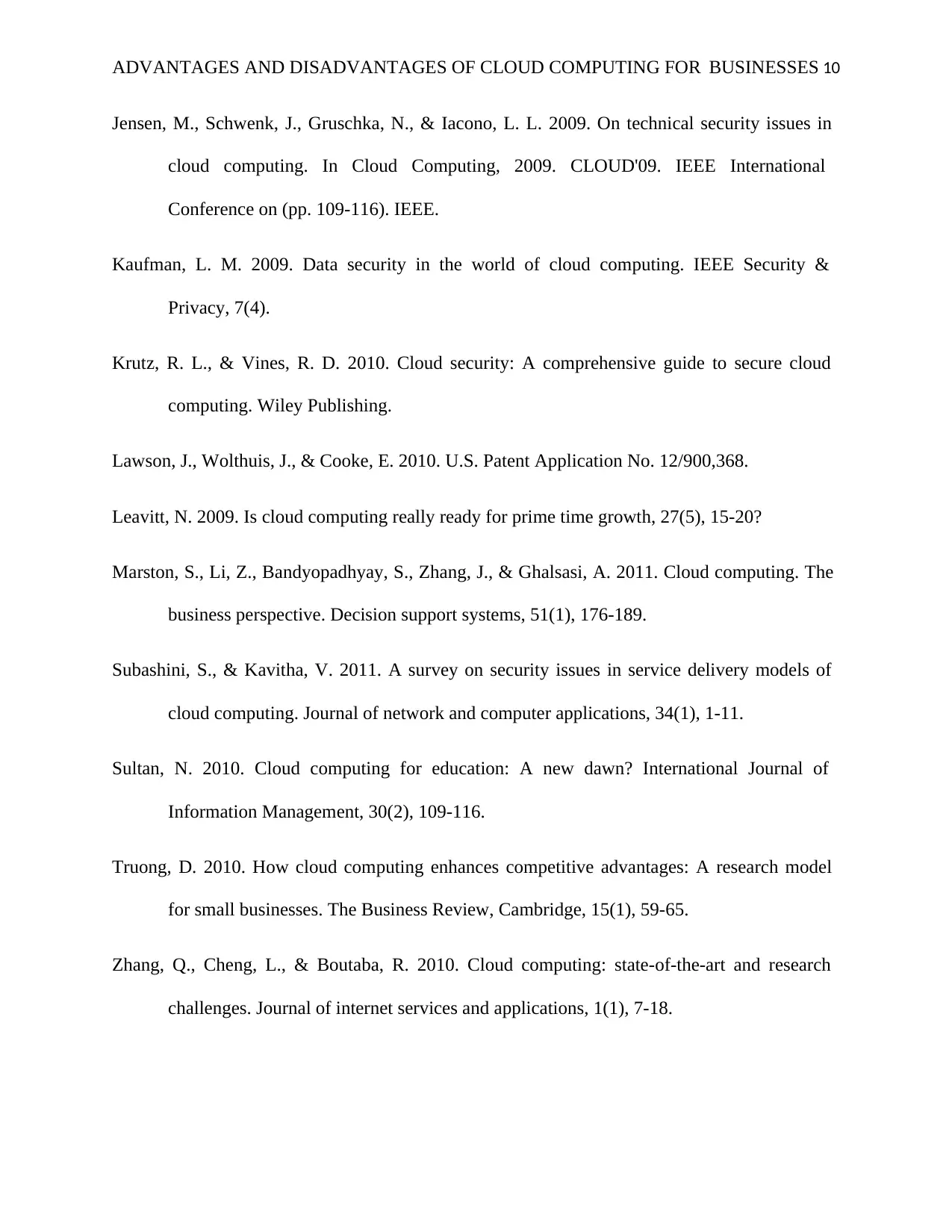
ADVANTAGES AND DISADVANTAGES OF CLOUD COMPUTING FOR BUSINESSES 10
Jensen, M., Schwenk, J., Gruschka, N., & Iacono, L. L. 2009. On technical security issues in
cloud computing. In Cloud Computing, 2009. CLOUD'09. IEEE International
Conference on (pp. 109-116). IEEE.
Kaufman, L. M. 2009. Data security in the world of cloud computing. IEEE Security &
Privacy, 7(4).
Krutz, R. L., & Vines, R. D. 2010. Cloud security: A comprehensive guide to secure cloud
computing. Wiley Publishing.
Lawson, J., Wolthuis, J., & Cooke, E. 2010. U.S. Patent Application No. 12/900,368.
Leavitt, N. 2009. Is cloud computing really ready for prime time growth, 27(5), 15-20?
Marston, S., Li, Z., Bandyopadhyay, S., Zhang, J., & Ghalsasi, A. 2011. Cloud computing. The
business perspective. Decision support systems, 51(1), 176-189.
Subashini, S., & Kavitha, V. 2011. A survey on security issues in service delivery models of
cloud computing. Journal of network and computer applications, 34(1), 1-11.
Sultan, N. 2010. Cloud computing for education: A new dawn? International Journal of
Information Management, 30(2), 109-116.
Truong, D. 2010. How cloud computing enhances competitive advantages: A research model
for small businesses. The Business Review, Cambridge, 15(1), 59-65.
Zhang, Q., Cheng, L., & Boutaba, R. 2010. Cloud computing: state-of-the-art and research
challenges. Journal of internet services and applications, 1(1), 7-18.
Jensen, M., Schwenk, J., Gruschka, N., & Iacono, L. L. 2009. On technical security issues in
cloud computing. In Cloud Computing, 2009. CLOUD'09. IEEE International
Conference on (pp. 109-116). IEEE.
Kaufman, L. M. 2009. Data security in the world of cloud computing. IEEE Security &
Privacy, 7(4).
Krutz, R. L., & Vines, R. D. 2010. Cloud security: A comprehensive guide to secure cloud
computing. Wiley Publishing.
Lawson, J., Wolthuis, J., & Cooke, E. 2010. U.S. Patent Application No. 12/900,368.
Leavitt, N. 2009. Is cloud computing really ready for prime time growth, 27(5), 15-20?
Marston, S., Li, Z., Bandyopadhyay, S., Zhang, J., & Ghalsasi, A. 2011. Cloud computing. The
business perspective. Decision support systems, 51(1), 176-189.
Subashini, S., & Kavitha, V. 2011. A survey on security issues in service delivery models of
cloud computing. Journal of network and computer applications, 34(1), 1-11.
Sultan, N. 2010. Cloud computing for education: A new dawn? International Journal of
Information Management, 30(2), 109-116.
Truong, D. 2010. How cloud computing enhances competitive advantages: A research model
for small businesses. The Business Review, Cambridge, 15(1), 59-65.
Zhang, Q., Cheng, L., & Boutaba, R. 2010. Cloud computing: state-of-the-art and research
challenges. Journal of internet services and applications, 1(1), 7-18.
1 out of 10
Related Documents
Your All-in-One AI-Powered Toolkit for Academic Success.
+13062052269
info@desklib.com
Available 24*7 on WhatsApp / Email
![[object Object]](/_next/static/media/star-bottom.7253800d.svg)
Unlock your academic potential
Copyright © 2020–2025 A2Z Services. All Rights Reserved. Developed and managed by ZUCOL.





